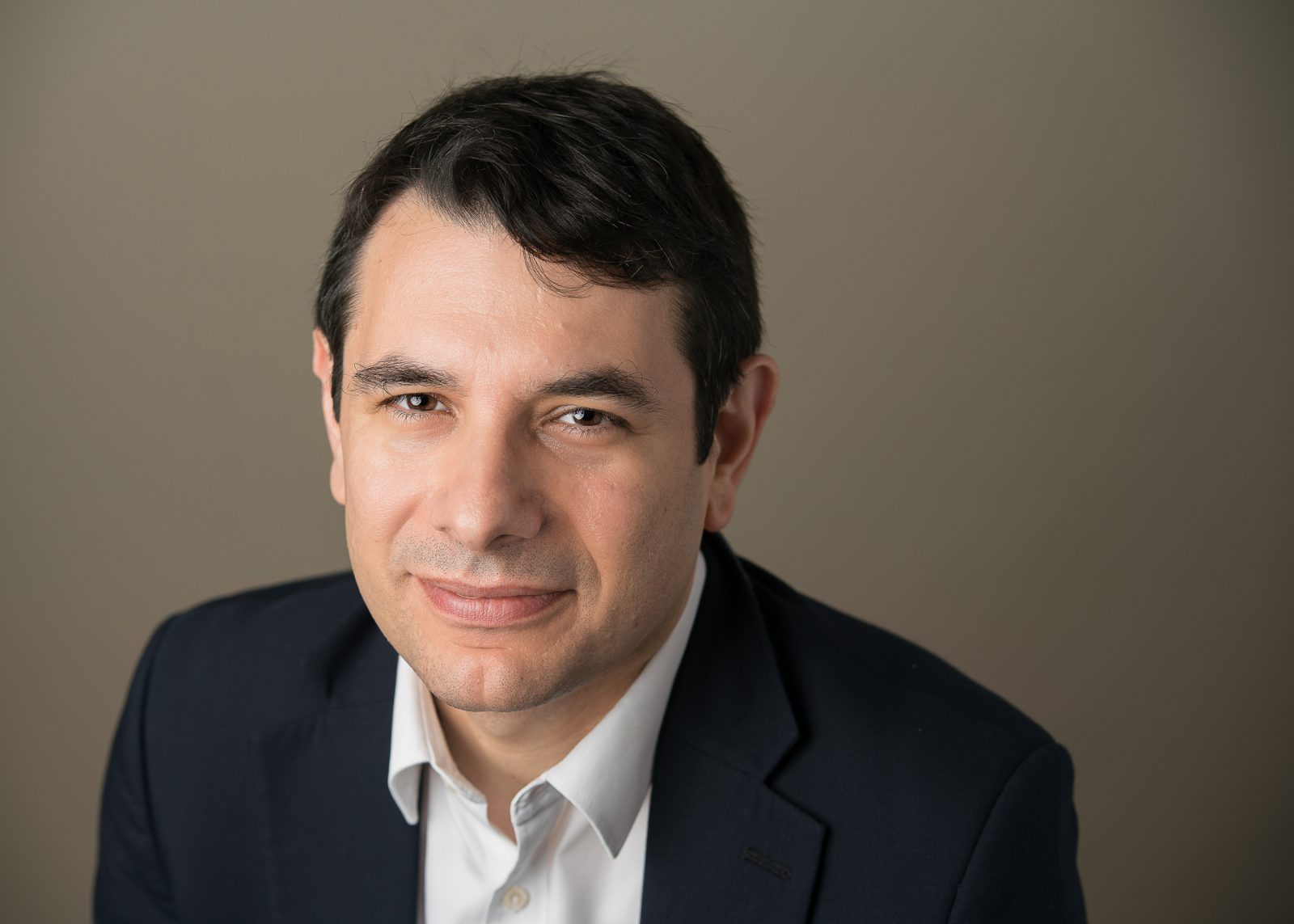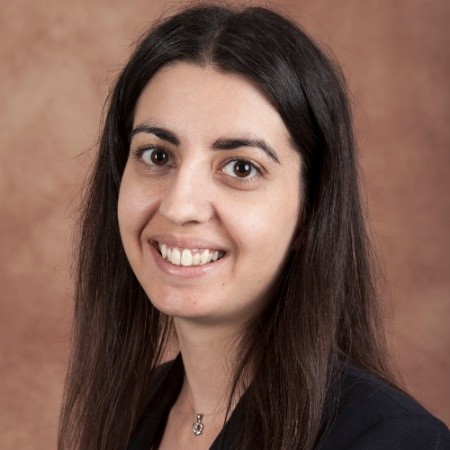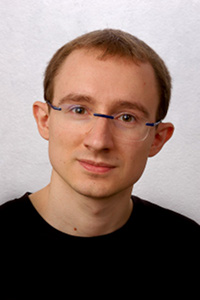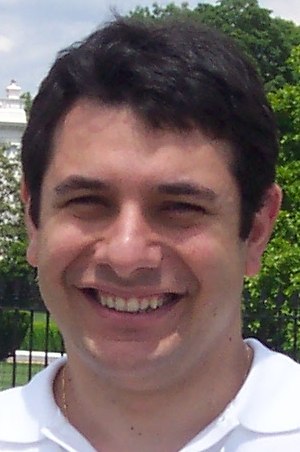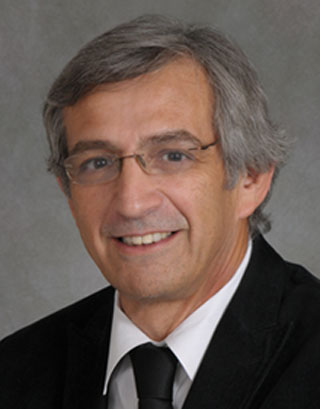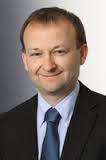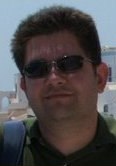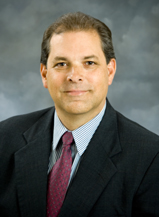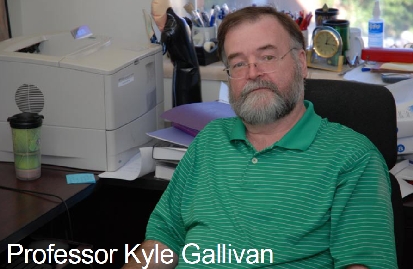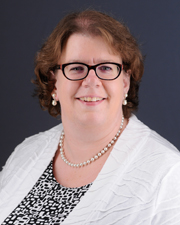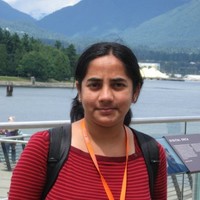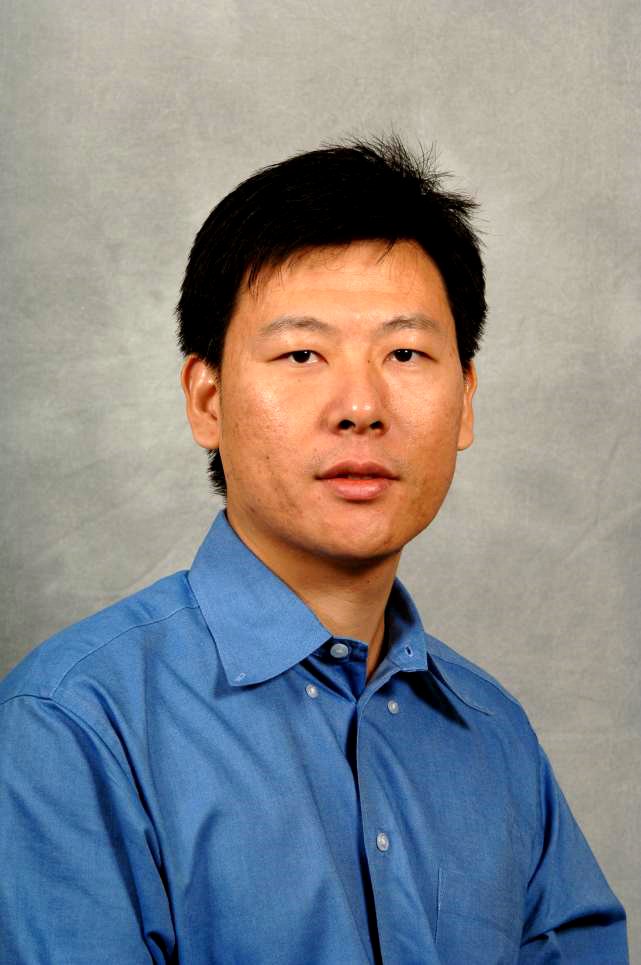Events
Contents
- 1 Seminars
- 1.1 Optimistic Cloud & Edge Computing Outside Hardware Boundaries
- 1.2 Serious Games and Simulations: applications, challenges and future directions
- 1.3 Black-Box Analysis
- 1.4 New Approaches to Energy-Efficient and Resilient HPC
- 1.5 Flow Diverters to Cure Cerebral Aneurysms a Case Study - From Concept to Clinical
- 1.6 Enhanced Surface Definition in Moving-Boundary Flow Simulation
- 1.7 Disrupting the power/performance/quality tradeoff through approximate and error-tolerant computing
- 1.8 Image-Based Mesh Generation and Volumetric Spline Modeling for Isogeometric Analysis
- 1.9 AFLR Unstructured Meshing Research Activities at CFD Modeling and Simulation Research at the Center for Advanced Vehicular Systems
- 1.10 Riemannian Optimization for Elastic Shape Analysis
- 1.11 A Parallel Log Barrier for Mesh Quality Improvement and Updating
- 2 Workshops
- 3 Outreach
Seminars
Optimistic Cloud & Edge Computing Outside Hardware Boundaries
Date: October 10, 2019
Presenter: Professor Dimitrios S. Nikolopoulos
Abstract: To address scaling limitations of future hardware, computing systems turned to parallelism and distribution. Most of the software and applications in science and engineering, but also applications that we use in our daily lives are actually distributed programs with some components running on edge or IoT devices to serve clients, data collectors or actuators, and other components running on data centers to provide data analytics, simulation, or visualization. The disaggregation of computing services raises new challenges for system challenges. We explores two of these challenges in this talk and discuss some solutions. The first challenge is that many applications necessitate low latency and more analytical power at or near the data sources. We demonstrate a system called TAPAS, which is neural network architecture search exploration engine. TAPAS uses aggressive compression, approximation and learning techniques to avoid entirely the simulation process in exploring neural network architectures. It further uses learning methods to adapt immediately to unseen data sets. TAPAS runs on a single low-power GPU and can train over 1,000 networks per second. This makes TAPAS suitable for training machine learning models on edge devices with limited resources. The second challenge is the one of scaling the performance and energy-efficiency of the hardware used in the Cloud and the Edge beyond current boundaries. We explore a co-designed compiler/OS/firmware system for characterizing hardware operating boundaries and safely operating hardware outside those boundaries to gain performance at the expense of additional, yet infrequent errors and mitigating actions. We demonstrate that many applications are inherently resilient to extended hardware boundaries and indeed benefit substantially from boundary relaxation.
Serious Games and Simulations: applications, challenges and future directions
Date: TBD, 2020
Presenter: Prof. Anastasia Angelopoulou
Abstract: Serious games and simulations have been steadily increasing their use in many sectors of society, particularly in education, defense, science and health. Their main purpose is usually to educate or train the users. In this talk, I will present my work in the area of serious games and simulations for training. I will also discuss challenges in the serious games development and future directions to overcome them.
Short Bio: Anastasia Angelopoulou is an Assistant Professor in Simulation and Gaming at the TSYS School of Computer Science at Columbus State University (CSU). Prior to joining CSU, she was a postdoctoral associate at the Institute for Simulation and Training at University of Central Florida (2016-2018), where she obtained her MSc and PhD in Modeling and Simulation (2015). Her research interests lie in the areas of modeling and simulation and serious games and their applications in domains such as healthcare, military, energy, and education, among others. Her research work has been partially supported by the Office of Naval Research and the National Science Foundation (NSF).
Black-Box Analysis
Date: TBD, 2020
Presenter: Dr. Daniele Panozzo
Abstract: The numerical solution of partial differential equations (PDE) is ubiquitous in computer graphics and engineering applications, ranging from the computation of UV maps and skinning weights, to the simulation of elastic deformations, fluids, and light scattering. Ideally, a PDE solver should be a “black box”: the user provides as input the domain boundary, boundary conditions, and the governing equations, and the code returns an evaluator that can compute the value of the solution at any point of the input domain. This is surprisingly far from being the case for all existing open-source or commercial software, despite the research efforts in this direction and the large academic and industrial interest. To a large extent, this is due to treating meshing and FEM basis construction as two disjoint problems.
I will present an integrated pipeline, considering meshing and element design as a single challenge, that makes the tradeoff between mesh quality and element complexity/cost local, instead of making an a priori decision for the whole pipeline. I will demonstrate that tackling the two problems jointly offers many advantages, and that a fully black-box meshing and analysis solution is already possible for heat transfer and elasticity problems.
Short Bio: Dr. Daniele Panozzo is an Assistant Professor of Computer Science at the Courant Institute of Mathematical Sciences in New York University. Prior to joining NYU he was a postdoctoral researcher at ETH Zurich (2012-2015). Daniele earned his PhD in Computer Science from the University of Genova (2012) and his doctoral thesis received the EUROGRAPHICS Award for Best PhD Thesis (2013). He received the EUROGRAPHICS Young Researcher Award in 2015 and the NSF CAREER Award in 2017. Daniele is leading the development of libigl (https://github.com/libigl/libigl), an award-winning (EUROGRAPHICS Symposium of Geometry Processing Software Award, 2015) open-source geometry processing library that supports academic and industrial research and practice. Daniele is chairing the Graphics Replicability Stamp (http://www.replicabilitystamp.org), which is an initiative to promote reproducibility of research results and to allow scientists and practitioners to immediately benefit from state-of-the-art research results. His research interests are in digital fabrication, geometry processing, architectural geometry, and discrete differential geometry.
New Approaches to Energy-Efficient and Resilient HPC
Date: Nov 12,2015, 10:30AM
Location: E & CS Auditorium, First Floor
Presenter: Professor Dimitrios S. Nikolopoulos
Abstract: This talk explores new and unconventional directions towards improving the energy-efficiency of HPC systems. Taking a workload-driven approach, we explore micro-servers with programmable accelerators; non-volatile main memory; workload auto-scaling and structured approximate computing. Our research in these has achieved significant gains in energy-efficiency while meeting application-specific QoS targets. The talk also reflects on a number of UK and European efforts to create a new energy-efficient and disaggregated ICT ecosystem for data analytics.
Flow Diverters to Cure Cerebral Aneurysms a Case Study - From Concept to Clinical
Date: Nov. 6, 2015, 10:30AM
Location: E & CS Auditorium, First Floor
Presenter: Professor Lieber, Baruch Barry
Abstract: en to fifteen million Americans are estimated to harbor intracranial aneurysms (abnormal bulges of blood vessels located in the brain) that can rupture and expel blood directly into the brain space outside of the arteries causing a stroke. A flow diverter, a refined tubular mesh-like device that is inserted through a small incision in the groin area (no need for open brain surgery) and navigated through a catheter into cerebral arteries to treat brain aneurysms is delivered into the artery carrying the aneurysm. The permeability of the device is optimized such that it significantly reduces the blood flow in the aneurysm, while keeping small side branches of the artery open to supply critical brain tissue. The biocompatible device elicits a healthy scar-response from the body that lines the inner metal surface of the device with biological tissue, thus restoring the diseased arterial segment to its normal state. Refinement in the design of such devices and prediction of their long term creative effect, which usually occurs over a period of months can be significantly helped by computer modeling and simulations of the flow alteration such devices impart to the aneurysm. The evolution of these devices will be discussed from conception to their current clinical use.
Enhanced Surface Definition in Moving-Boundary Flow Simulation
Date: July 31, 2015, 10:30AM
Location: E & CS Auditorium, First Floor
Presenter: Professor Marek Behr
Abstract: Moving-boundary flow simulations are an important design and analysis tool in many areas of engineering, including civil and biomedical engineering, as well as production engineering [1]. While interface-capturing offers unmatched flexibility for complex free-surface motion, the interface-tracking approach is very attractive due to its better mass conservation properties at low resolution. We focus on interface-tracking moving-boundary flow simulations based on stabilized discretizations of Navier-Stokes equations, space-time formulations on moving grids, and mesh update mechanisms based on elasticity. However, we also develop techniques that promise to increase the fidelity of the interface-capturing methods.
In order to obtain accurate and smooth shape description of the free surface, as well as accurate flow approximation on coarse meshes, the approach of NURBS-enhanced finite elements (NEFEM) [2] is being applied to various aspects of free-surface flow computations. In NEFEM, certain parts of the boundary of the computational domain are represented using non-uniform rational B-splines (NURBS), therefore making it an effective technique to accurately treat curved boundaries, not only in terms of geometry representation, but also in terms of solution accuracy.
As a step in the direction of NEFEM, the benefits of a purely geometrical NURBS representation of the free-surface could already be shown [3]. The first results with a full NEFEM approach for the flow variables in the vicinity of the moving free surface have also been obtained. The applications include both production engineering, i.e., die swell in plastics processing simulation, and safety engineering, i.e., sloshing phenomena in fluid tanks subjected to external excitation.
Space-time approaches offer some not-yet-fully-exploited advantages when compared to standard discretizations (finite-difference in time and finite-element in space, using either method of Rothe or method of lines); among them, the potential to allow some degree of unstructured space-time meshing. A method for generating simplex space-time meshes is presented, allowing arbitrary temporal refinement in selected portions of space-time slabs. The method increases the flexibility of space-time discretizations, even in the absence of dedicated space-time mesh generation tools. The resulting tetrahedral (for 2D problems) and pentatope (for 3D problems) meshes are tested in the context of advection-diffusion equation, and are shown to provide reasonable solutions, while enabling varying time refinement in portions of the domain [4].
[1] S. Elgeti, M. Probst, C. Windeck, M. Behr, W. Michaeli, and C. Hopmann, "Numerical shape optimization as an approach to extrusion die design", Finite Elements in Analysis and Design, 61, 35–43 (2012).
[2] R. Sevilla, S. Fernandez-Mendez and A. Huerta, "NURBS-Enhanced Finite Element Method (NEFEM)", International Journal for Numerical Methods in Engineering, 76, 56–83 (2008).
[3] S. Elgeti, H. Sauerland, L. Pauli, and M. Behr, "On the Usage of NURBS as Interface Representation in Free-Surface Flows", International Journal for Numerical Methods in Fluids, 69, 73–87 (2012).
[4] M. Behr, "Simplex Space-Time Meshes in Finite Element Simulations", International Journal for Numerical Methods in Fluids, 57, 1421–1434, (2008).
Disrupting the power/performance/quality tradeoff through approximate and error-tolerant computing
Date: June 25, 2015, 10:30AM
Location: E & CS Auditorium, First Floor
Presenter: Professor Christos Antonopoulos
Abstract: A major obstacle in the path towards exascale computing is the necessity to improve the energy efficiency of systems by two orders of magnitude. Embedded computing also faces similar challenges, in an era when traditional techniques, such as DVFS and Vdd scaling, yield very limited additional returns. Heterogeneous platforms are popular due to their power efficiency. They usually consist of a host processor and a number of accelerators (typically GPUs). They may also integrate multiple cores or processors with inherently different characteristics, or even just configured differently. Additional energy gains can be achieved for certain classes of applications by approximating computations, or in a more aggressive setting even tolerating errors. These opportunities, however, have to be exploited in a careful, educated manner, otherwise they may introduce significant development overhead and may also result to catastrophic failures or uncontrolled degradation of the quality of results. Introducing and tolerating approximations and errors in a disciplined and effective way requires rethinking, redesigning and re-engineering all layers of the system stack, from programming models down to hardware. We will present our experiences from this endeavor in the context of two research projects: Centaurus (co-funded by GR an EU) and SCoRPiO (EU FET-Open). We will also discuss our perspective on the main obstacles preventing the wider adoption of approximate and error-aware computing and the necessary steps to be taken to that end.
Image-Based Mesh Generation and Volumetric Spline Modeling for Isogeometric Analysis
Date: April 24, 2015, 10:30AM
Location: E & CS Auditorium, First Floor
Presenter: Professor Yongjie Jessica Zhang
Abstract: With finite element methods and scanning technologies seeing increased use in many research areas, there is an emerging need for high-fidelity geometric modeling and mesh generation of spatially realistic domains. In this talk, I will highlight our research in three areas: image-based mesh generation for complicated domains, trivariate spline modeling for isogeometric analysis, as well as biomedical, material sciences and engineering applications. I will first present advances and challenges in image-based geometric modeling and meshing along with a comprehensive computational framework, which integrates image processing, geometric modeling, mesh generation and quality improvement with multi-scale analysis at molecular, cellular, tissue and organ scales. Different from other existing methods, the presented framework supports five unique features: high-fidelity meshing for heterogeneous domains with topology ambiguity resolved; multiscale geometric modeling for biomolecular complexes; automatic all-hexahedral mesh generation with sharp feature preservation; robust quality improvement for non-manifold meshes; and guaranteed-quality meshing. These unique capabilities enable accurate, stable, and efficient mechanics calculation for many biomedicine, materials science and engineering applications.
In the second part of this talk, I will show our latest research on volumetric spline parameterization, which contributes directly to the integration of design and analysis, the root idea of isogeometric analysis. For arbitrary topology objects, we first build a polycube whose topology is equivalent to the input geometry and it serves as the parametric domain for the following trivariate T-spline construction. Boolean operations and geometry skeleton can also be used to preserve surface features. A parametric mapping is then used to build a one-to-one correspondence between the input geometry and the polycube boundary. After that, we choose the deformed octree subdivision of the polycube as the initial T-mesh, and make it valid through pillowing, quality improvement, and applying templates or truncation mechanism couple with subdivision to handle extraordinary nodes. The parametric mapping method has been further extended to conformal solid T-spline construction with the input surface parameterization preserved and trimming curves handled.
AFLR Unstructured Meshing Research Activities at CFD Modeling and Simulation Research at the Center for Advanced Vehicular Systems
Date: March 20, 2015, 10:30AM
Location: E & CS Auditorium, First Floor
Presenter: Professor David Marcum
Abstract: Mesh generation and associated geometry preparation are critical aspects of any computational field simulation (CFS) process. In particular the mesh used can have a significant impact on accuracy, effectiveness, and efficiency of the CFS solver. Further, typical users spend a considerable portion of their time for the overall effort on mesh and geometry issues. All of this is particularly critical for CFD applications. AFLR is an unstructured mesh generator designed with a focus on addressing these issues for complex geometries. It is widely used, readily available to Government and Academic users, and has been very successful with relevant problems. AFLR volume and surface meshing is also directly incorporated in several systems, including: DoD CREATE-MG Capstone, Lockheed Martin/DoD ACAD, Boeing MADCAP, MSU SolidMesh, and Altair HyperMesh. In this talk we will provide an overview of this technology, future directions, and plans for multi-tasking/parallel operation.
Riemannian Optimization for Elastic Shape Analysis
Date: January 23, 2015, 10:30AM
Location: E & CS Auditorium, First Floor
Presenter: Professor Kyle Gallivan
Abstract: In elastic shape analysis, a representation of a shape is invariant to translation, scaling, rotation and reparameterization and important problems (such as computing the distance and geodesic between two curves, the mean of a set of curves, and other statistical analyses) require finding a best rotation and re-parameterization between two curves. In this talk, I focus on this key subproblem and study different tools for optimizations on the joint group of rotations and re-parameterizations. I will give a brief account of a novel Riemannian optimization approach and evaluate its use in computing the distance between two curves and classification using two public data sets. Experiments show significant advantages in computational time and reliability in performance compared to the current state-of-the-art method.
Bio: Kyle A. Gallivan is a Professor of Mathematics at Florida State University. Gallivan received the Ph.D. in Computer Science from the University of Illinois at Urbana-Champaign in 1983 under the direction of C. W. Gear. He worked on special purpose signal processors in the Government Aerospace Systems Division of Harris Corporation. He was a research computer scientist at the Center for Supercomputing Research and Development at the University of Illinois from 1985 until 1993 when he moved to the Department of Electrical and Computer Engineering. From 1997 to 2008 he was a member of the Department of Computer Science at Florida State University (FSU) and a member of the Computational Science and Engineering group becoming a full Professor in 1999. He became a Professor of Mathematics at FSU in 2008 and was selected the 2012 Pascal Professor for the Faculty of Sciences of the University of Leiden in the Netherlands. He has been a Visiting Professor at the Catholic University of Louvain in Belgium multiple times through a long-standing research collaboration with colleagues there.
Over the years Gallivan's research has included: design and analysis of high-performance numerical algorithms, pioneering work on block algorithms for numerical linear algebra, performance analysis of the experimental Cedar system, restructuring compilers, model reduction of large scale differential equations, and high-performance codes for application such as ocean circulation, circuit simulation and the codes in the Perfect Benchmark Suite. Gallivan's current main research concerns optimization algorithms on Riemannian manifolds and their use in applications such as shape analysis, statistics, and signal/image processing.A Parallel Log Barrier for Mesh Quality Improvement and Updating
Date: November 7, 2014, 10:30AM
Location: E & CS Auditorium, First Floor
Presenter: Professor Suzanne M. Shontz
Abstract: There are numerous applications in science, engineering, and medicine which require high-quality meshes, i.e., discretizations of the geometry, for use in computational simulations. For example, meshes have been used to enable accurate prediction of the performance, reliability, and safety of solid propellant rockets. The movie industry in Hollywood typically employs dynamic meshes in order to animate characters in films. Large-scale applications often require meshes with millions to billions of elements that are generated and manipulated in parallel. The advent of supercomputers with hundreds to thousands of cores has made this possible.
The focus of my talk will be on parallel algorithms for mesh quality improvement and mesh untangling. Such algorithms are needed, for example, when a large-scale mesh deformation is applied and tangled and/or low quality meshes are the result. Prior efforts in these areas have focused on the development of parallel algorithms for mesh generation and local mesh quality improvement in which only one vertex is moved at a time. In contrast, we are concerned with the development of parallel global algorithms for mesh quality improvement and untangling in which all vertices are moved simultaneously. I will present our parallel log-barrier mesh quality improvement and untangling algorithms for distributed-memory machines. Our algorithms simultaneously move the mesh vertices in order to optimize a log-barrier objective function that was designed to improve the quality of the worst quality mesh elements. We employ an edge coloring-based algorithm for synchronizing unstructured communication among the processes executing the log-barrier mesh optimization algorithm. The main contribution of this work is a generic scheme for global mesh optimization. The algorithm shows greater strong scaling efficiency compared to an existing parallel mesh quality improvement technique. Portions of this talk represent joint work with Shankar Prasad Sastry, University of Utah, and Stephen Vavasis, University of Waterloo.
Bio:Suzanne M. Shontz is an Associate Professor in the Department of Electrical Engineering and Computer Science at the University of Kansas. She is also affiliated with the Graduate Program in Bioengineering and the Information and Telecommunication Technology Center. Prior to joining the University of Kansas in 2014, Suzanne was on the faculty at Mississippi State and Pennsylvania State Universities. She was also a postdoc at the University of Minnesota and earned her Ph.D. in Applied Mathematics from Cornell University.
Suzanne's research efforts focus centrally on parallel scientific computing, more specifically, the design and analysis of unstructured mesh, numerical optimization, model order reduction, and numerical linear algebra algorithms and their applications to medicine, images, electronic circuits, materials, and other applications. In 2012, she was awarded an NSF Presidential Early CAREER Award (i.e., NSF PECASE Award) by President Obama for her research in computational- and data-enabled science and engineering. Suzanne also received an NSF CAREER Award for her research on parallel dynamic meshing algorithms, theory, and software for simulation-assisted medical interventions in 2011 and a Summer Faculty Fellowship from the Office of Naval Research in 2009. She has chaired or co-chaired several top conferences in computational- and data-enabled science and engineering including the International Meshing Roundtable in 2010 and the NSF CyberBridges Workshop in 2012-2014 and has served on numerous program committees in the field. Suzanne is also an Associate Editor for the Book Series in Medicine by De Gruyter Open.Workshops
Parallel Software Runtime System Workshop
Date: 24-25 May 2017
Location: NASA/LaRC & NIA
Participants: Pete Beckman (ANL), Halim Amer (ANL), Dana P. Hammond (NASA LaRC), Nikos Chrisochoides (ODU), Andriy Kot (NCSA,UIUC), Fotis Drakopoulos (ODU), Thomas Kennedy (ODU), Christos Tsolakis (ODU), Kevin Garner (ODU), Polykarpos Thomadakis (ODU)
Isotropic Advancing Front Local Reconnection Hands-On Workshop
Location: March 20-21, 2015
Participants: NASA/LaRC : Dr Bill Jones , Dr Mike Mark, Dr Dana Hamond, ODU: Nikos Chrisochoides, Fotis Drakopoulos (ODU), Thomas Kennedy (ODU), Christos Tsolakis (ODU), Kevin Garner (ODU), Polykarpos Thomadakis (ODU)
HPC Middleware for Mesh Generation and High Order Geometry Approximation Workshop
Attendants: (NASA/LaRC) Dr Bill Jones , Dr Mike Mark, Dr Dana Hamond,(NIA) Boris Diskin ODU: Nikos Chrisochoides
- Dr. Navamita Ray
- Los Alamos National Laboratory, Mathematics and Computer Science Division
- Los Alamos, New Mexico
- When: March 25,2016, 10:30AM
- Where: E & CS Auditorium, First Floor
- What: Towards Scalable Framework for Geometry and Meshing in Scientific Computing
- Email: navamitaray@gmail.com
- ABSTRACT
- High fidelity computational modeling of complex, coupled physical phenomena occurring in several scientific fields require accurate resolution of intricate geometry features, generation of good quality unstructured meshes that minimize modeling errors, scalable interfaces to load/manipulate/traverse these meshes in memory and support I/O for check-pointing and in-situ visualization. While several applications tend to create custom HPC solutions to tackle the heterogeneous descriptions of physical models, such approaches lack in generality, interoperability and extensibility making it difficult to maintain scalability of the individual representations. In this talk, we introduce the component-based open-source SIGMA (Scalable Interfaces for Geometry and Mesh based Applications) toolkit, an effort to address these issues. We focus particularly on its array-based unstructured mesh representation component, Mesh Oriented datABase (MOAB) that provides scalable interfaces to geometry, mesh and solvers to allow seamless integration to computational workflows.
- Based on the three fundamental units consisting of 1) compact array-based memory management for mesh and field data,2) efficient mesh data structures for traverals and querying, and 3) scalable parallel communication algorithms for distributed meshes, MOAB supports various advanced algorithms such as I/O, in-memory mesh modification and refinement, multi-mesh projections, high-order boundary reconstruction, etc. We discuss some of these advanced algorithms and their applications.
- Bio: Dr. Navamita Ray is a postdoctoral appointee and part of the SIGMA team at Mathematics and Computer Science Division at Argonne National Laboratory, Argonne, IL. She has been involved in research on flexible mesh data structures for mesh adaptivity as well as high-fidelity discrete boundary representation. Dr. Ray holds a Ph.D. in Applied Mathematics from the Stony Brook University, where she did graduate work on high-order surface reconstruction and its applications to surface integrals and remeshing. </li>
- Dr. Xiangmin (Jim) Jiao
- Associate Professor and AMS Ph.D. Program Director, Department of Applied Mathematics and Statistics and Institute for Advanced Computational Science
- Stony Brook University
- When: March 3,2016, 10:30AM
- Where: E & CS Auditorium, First Floor
- What: Robust Adaptive High-Order Geometric and Numerical Methods Based on Weighted Least Squares
- Email: xiangmin.jiao@stonybrook.edu:
- Homepage: http://www.ams.sunysb.edu/~jiao
- ABSTRACT
- Numerical solutions of partial differential equations (PDEs) are important for modeling and simulations in many scientific and engineering applications. Their solutions over complex geometries pose significant challenges in efficient surface and volume mesh generation and robust numerical discretizations. In this talk, we present our recent work in tackling these challenges from two aspects. First, we will present accurate and robust high-order geometric algorithms on discrete surface, to support high-order surface reconstruction, surface mesh generation and adaptation, and computation of differential geometric operators, without the need to access the CAD models. Secondly, we present some new numerical discretization techniques, including a generalized finite element method based on adaptive extended stencils,and a novel essentially nonoscillatory scheme for hyperbolic conservation laws on unstructured meshes. These new discretizations are more tolerant of mesh quality and allow accurate, stable and efficient computations even on meshes with poorly shaped elements. Based on a unified theoretical framework of weighted least squares, these techniques can significantly simplify the mesh generation processes, especially on supercomputers, and also enable more efficient and robust numerical computations. We will present the theoretical foundation of our methods and demonstrate their applications for mesh generation and numerical solutions of PDEs.
- Bio: Dr. Xiangmin (Jim) Jiao is an Associated Professor in Applied Mathematics and Computer Science, and also a core faculty member of the Institute for Advanced Computational Science at Stony Brook University. He received his Ph.D. in Computer Science in 2001 from University of Illinois at Urbana-Champaign (UIUC). He was a Research Scientist at the Center for Simulation of Advanced Rockets (CSAR) at UIUC between 2001 and 2005, and then an Assistant Professor in College of Computing at Georgia Institute of Technology between 2005 and 2007. His research interests focus on high-performance geometric and numerical computing, including applied computational and differential geometry, generalized finite difference and finite element methods, multigrid and iterative methods for sparse linear systems, multiphysics coupling, and problem solving environments, with applications in computational fluid dynamics, structural mechanics, biomedical engineering, climate modeling, etc.
CNF Imaging Workshop
- When: August 2019
- Where: tbd
- More Information: CNF Imaging Workshop
Outreach
Surgical Planning Lab
When : April 8 & 9 , 2016 Where : Brigham and Women's Hospital & Harvard Medical School, Boston
Posters presented in 25th anniversary of SPL :
Fotis Drakopoulos and Nikos Chrisochoides : Lattice-Based Multi-Tissue Mesh Generation for Biomedical Applications
Fotis Drakopoulos and Nikos Chrisochoides : Deformable Registration of Pre-Op MRI with iMRI for Brain Tumor Resection: Progress Report
Nikos Chrisochoides, Andrey Chernikov and Christos Tsolakis : Extreme Scale Mesh Generation for Big-Data Medical Images
